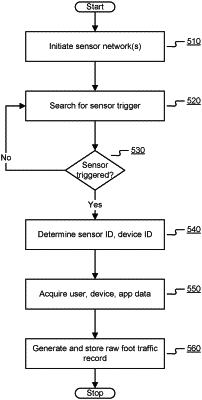| CPC G06Q 30/0205 (2013.01) [G06Q 10/087 (2013.01)] | 20 Claims |

|
1. An in-store customer traffic analysis system, comprising:
a sensor network comprising a plurality of biometric sensors positioned within a retail store, the plurality of biometric sensors comprising a first sensor;
a plurality of displays comprising a first display;
one or more memory devices storing instructions; and
one or more hardware processors configured to execute the instructions to:
receive, from the sensor network over an electronic communications network, a first sensor signal indicating that a first user has been recognized by the first sensor;
determine, based on a first user identifier within the first sensor signal, a first user demographic category associated with the first user;
obtain demographic-display data associated with the first user demographic category;
determine a recommendation to be displayed in the first display based on the demographic-display data;
generate a processor-executable instruction to modify directional signage of the first display towards a product in the retail store according to the recommendation;
determine, based on sensor data from the sensor network, a direction from which the first user approached the first display and an amount of time the first user spent within a proximity of the first display, wherein the direction is determined using a directional sensor within the sensor network;
calculate a first score based on the amount of time the first user spent within the proximity of the first display and the direction from which the first user approached the first display;
associate the first score with the first user demographic category;
generate, based on the first score, a display-demographic map indicating a correlation between the first display and the first user demographic category; and
store the display-demographic map.
|